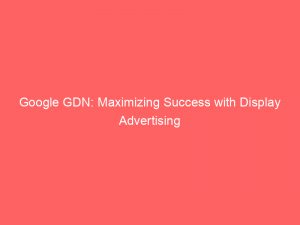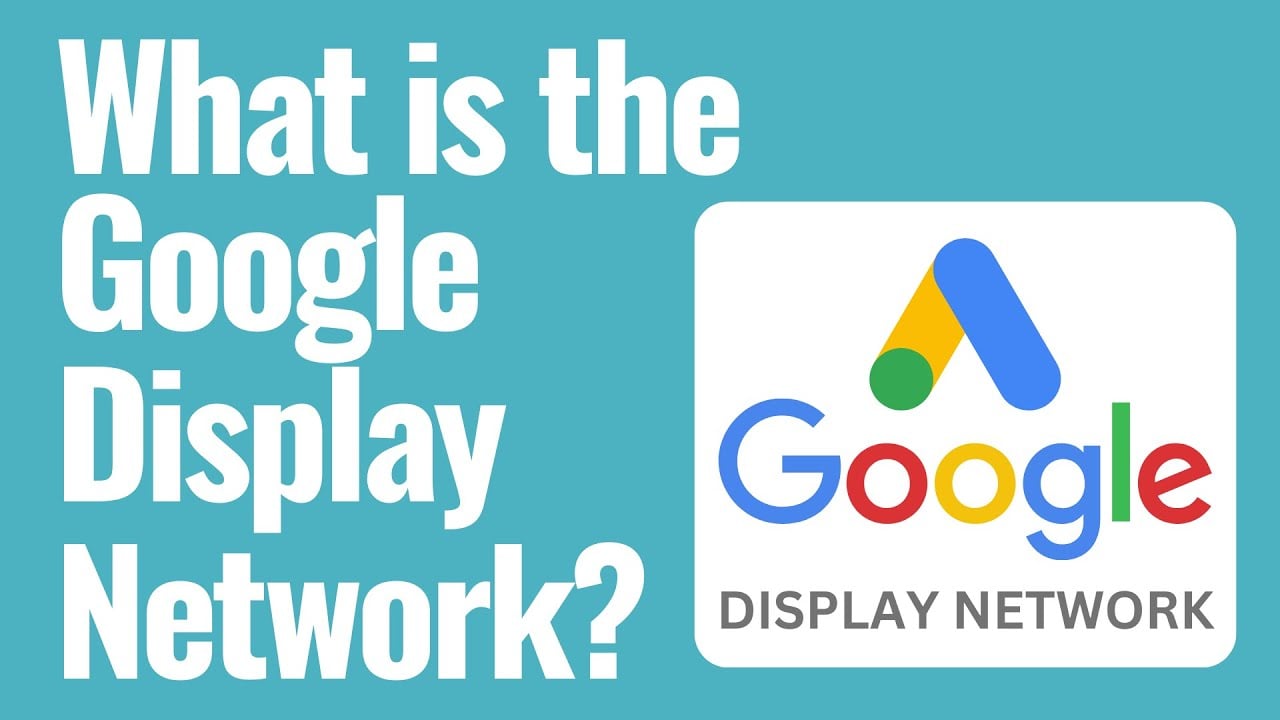- google gdn
- 1. Three Categories Of Interest Targeting
- 2. Reach Global Internet Users With Google Display Network (GDN)
- 3. Customize Audience Targeting With GDN
- 4. High Volume Of Impressions Across Millions Of Websites
- 5. GDN Reaches Non-Searching Users
- 6. Prospect And Remarketing Targeting Options With GDN
- 7. Various Ad Types On GDN
- 8. Optimization Strategies For GDN
In the vast virtual landscape of the internet, where billions of users navigate through countless websites and platforms, how can advertisers connect with the right audience and make an impactful impression? Enter Google Display Network (GDN), the digital realm where personalized ads take flight and captivate the interests of potential customers.
With interest targeting on GDN, advertisers wield the power to reach precisely those individuals who are not only interested in their products but immersed in related activities, amplifying the potential for engagement and conversions. This remarkable customization of audience targeting, combined with an array of compelling ad types and optimization strategies, forms an irresistible recipe for advertising success.
Join us on this journey as we reveal the captivating world of interest targeting on Google Display Network.
| Item | Details |
|---|---|
| Topic | Google GDN: Maximizing Success with Display Advertising |
| Category | Ads |
| Key takeaway | In the vast virtual landscape of the internet, where billions of users navigate through countless websites and platforms, how can advertisers connect with the right audience and ma |
| Last updated | December 27, 2025 |
google gdn
Google GDN, or Google Display Network, is a powerful advertising platform that allows advertisers to reach a wide range of users interested in their products or related activities. It offers three categories of interest targeting, including Affinity Audiences, Custom Affinity Audiences, and In-Market Audiences.
With a reach of 90% of global internet users, GDN provides a high volume of impressions across millions of websites. While GDN may have a lower click-through rate compared to search ads, it enables advertisers to reach users who may not be actively searching.
GDN offers customization of audience targeting, remarketing options, various ad types, and optimization strategies for improved effectiveness. Tools like CleverAds can assist with ad creation and management on GDN.Key Points:
- Google GDN is an advertising platform that helps advertisers target users interested in their products or related activities.
- GDN offers three categories of interest targeting: Affinity Audiences, Custom Affinity Audiences, and In-Market Audiences.
- With a reach of 90% of global internet users, GDN provides a high volume of impressions across millions of websites.
- GDN allows advertisers to reach users who may not be actively searching, unlike search ads.
- GDN offers customization of audience targeting, remarketing options, various ad types, and optimization strategies.
- Tools like CleverAds can assist with ad creation and management on GDN.
Sources
https://ads.google.com/intl/en_ID/home/resources/reach-larger-new-audiences/
https://blog.hubspot.com/marketing/google-display-network
https://ads.google.com/intl/en_us/home/resources/articles/reach-larger-new-audiences/
https://cybercashworldwide.com/what-is-google-display-network
Check this out:
💡 Pro Tips:
1. Use demographic performance assessment for optimization: Analyze the demographic data of your GDN campaign to identify which segments are performing well and adjust your targeting accordingly.
2. Take advantage of location customization: Customize your GDN campaign to target specific locations where your target audience is located. This can help increase the relevance of your ads and improve campaign performance.
3. Implement mobile targeting: With the increasing number of mobile users, ensure that your GDN ads are optimized for mobile devices. Consider using mobile-specific ad formats and targeting options to reach your mobile audience effectively.
4. Leverage analytics for effectiveness: Utilize analytics tools to track the performance of your GDN campaign and identify areas for improvement. Analyze metrics such as click-through rates, conversions, and engagement to optimize your ads and maximize effectiveness.
5. Utilize content exclusion settings: Prevent your ads from appearing on undesirable websites by using content exclusion settings. Exclude specific websites or categories of websites that may not align with your brand or target audience to maintain brand safety and improve campaign performance.
1. Three Categories Of Interest Targeting
Interest targeting on Google GDN allows advertisers to effectively reach people who are interested in their products or related activities. There are three categories of interest targeting available:
- Affinity Audiences: These audiences are based on users’ overall interests and habits. Advertisers can choose from various affinity audiences such as music lovers, sports enthusiasts, or travel enthusiasts.
This targeting method allows advertisers to reach a broad audience that shares specific interests.
- Custom Affinity Audiences: Custom affinity audiences are created based on advertisers’ specific preferences. Advertisers can input keywords, URLs, or apps related to their target audience.
For example, a company selling fitness products can create a custom affinity audience by adding keywords like “workout,” “healthy lifestyle,” and “nutrition.” This targeting method enables advertisers to reach a more tailored audience.
- In-Market Audiences: In-market audiences consist of people who are actively researching or considering purchasing products or services in a particular category. Advertisers can select from a wide range of in-market categories such as automotive, fashion, or home improvement.
This type of targeting is highly effective for reaching users who are close to making a purchase decision.
With these three categories of interest targeting, advertisers can effectively reach their target audience based on their interests and purchase intent.
2. Reach Global Internet Users With Google Display Network (GDN)
The Google Display Network (GDN) is a robust advertising platform that reaches a staggering 90% of global internet users. This extensive reach allows advertisers to connect with a vast audience from all corners of the world.
The GDN encompasses millions of websites, including popular destinations such as news sites, blogs, and social media platforms.
By leveraging the GDN, advertisers have the opportunity to display their ads to a wide range of internet users. This broad reach enables brands to increase their visibility and capture the attention of potential customers on a global scale.
Whether an advertiser wants to promote a new product or raise brand awareness, the GDN provides the platform to reach a massive audience.
3. Customize Audience Targeting With GDN
Google GDN offers advertisers extensive customization options for audience targeting. Advertisers can tailor their campaigns to reach specific audience affinities, in-market segments, and even target users based on custom intent keywords.
Audience Affinities: Advertisers can choose from a range of audience affinities to connect with users who share common interests or behaviors. This targeting method allows advertisers to refine their audience based on detailed profiling.
In-Market Segments: By selecting in-market segments, advertisers can target users who are actively researching or considering products or services related to their offering. This method ensures that ads are delivered to users who are more likely to convert.
Custom Intent Keywords: Advertisers can identify their target audience by utilizing custom intent keywords. These keywords are based on users’ search behavior and can be used to refine targeting.
Updated for 2025’s advertising best practices.
For example, a car dealership can use custom intent keywords like “buy a new car” or “auto financing” to reach users who are actively interested in purchasing a vehicle.
GDN’s customization options allow advertisers to hone in on their specific target audience, ensuring that their ads are delivered to the right people at the right time.
4. High Volume Of Impressions Across Millions Of Websites
One of the major advantages of using Google GDN for display advertising is the high volume of impressions it offers. With millions of websites in its network, GDN presents advertisers with a vast inventory of advertising spaces.
This extensive reach allows advertisers to achieve a significant number of impressions to maximize their brand exposure.
By having access to a wide range of websites, advertisers can target their audience across various niches and industries. This comprehensive coverage ensures that their ads reach users who are browsing websites related to their products or services.
The high volume of impressions on GDN provides advertisers with ample opportunities to showcase their brand, products, or services to a large number of internet users.
5. GDN Reaches Non-Searching Users
While search ads are highly effective in reaching users who are actively searching for products or services, Google GDN extends advertisers’ reach beyond just search. GDN allows advertisers to reach users who may not be actively searching but still have interests or habits related to their offerings.
By utilizing the interest targeting options offered by GDN, advertisers can tap into the potential of reaching users who may not yet be aware of their products or services. This approach expands the reach of advertising campaigns and enables advertisers to connect with a wider audience base.
GDN’s ability to reach non-searching users allows advertisers to raise awareness, generate interest, and influence potential customers who may be in the early stages of the buying journey.
6. Prospect And Remarketing Targeting Options With GDN
Google GDN offers a range of targeting options that cater to both prospecting and remarketing campaigns. These options allow advertisers to effectively reach both new prospects and previous website visitors who have shown interest in their brand.
Prospecting: Advertisers can use interest targeting options, such as affinity audiences and in-market segments, to identify new prospects who have the potential to convert. By reaching out to users who have exhibited behaviors or interests related to their offering, advertisers can widen their customer base and attract fresh leads.
Remarketing: GDN also enables advertisers to retarget users who have previously visited their website. Remarketing audiences can be tailored to various user actions, such as general website visitors, form submitters, and product page viewers.
By retargeting these users with personalized ads, advertisers can re-engage potential customers and encourage them to complete a purchase or take other desired actions.
The combination of prospecting and remarketing targeting options offered by GDN allows advertisers to effectively reach both new prospects and engaged website visitors.
7. Various Ad Types On GDN
When advertising on Google GDN, advertisers have access to various ad types that can be utilized to capture their audience’s attention. These ad types include:
By leveraging these various ad types, advertisers can choose the format that best suits their brand, message, and campaign objectives.
8. Optimization Strategies For GDN
To maximize the effectiveness of their ad campaigns on Google GDN, advertisers should employ optimization strategies. Here are some key optimization tactics to consider:
Identify the highest-performing placements and consider adjusting bids or excluding low-performing placements to increase ROI.
By implementing these optimization strategies, advertisers can enhance the performance and effectiveness of their campaigns on Google GDN.
In conclusion, Google GDN provides advertisers with a powerful platform to reach a broad audience of global internet users. With interest targeting options, extensive customization features, and various ad formats, advertisers can maximize their success in display advertising.
By utilizing optimization strategies and leveraging the vast reach and impression volume of GDN, advertisers can connect with their target audience, increase brand awareness, and drive results.
Performance Marketing Tips • Programmatic Advertising • Native Ad Network • Buy Traffic











